Manitoba Insect and Disease Update: Week of July 22, 2013
Recent Insect and Plant Pathogen Activity
Grasshoppers: Grasshoppers continue to be a concern in many areas. Below are some of the more common questions on grasshoppers that some have been asking:
Will they feed on the heads of wheat? Possibly. The initial feeding is likely to be on the leaves. As the plants get more mature and start to senesce, grasshoppers may move and look for more suitable hosts. But at times they will feed on the head or clip heads. So when assessing populations of grasshoppers, consider what they are feeding on as well as the levels.
Grasshoppers are present in the field but not causing a lot of damage to the crop; how concerned should we be? There are lots of different species of grasshoppers, but only 4 that we consider to be potential crop pests. Of these 4 species, the preference for food choices varies. There may be some weeds in or around the field, or vegetation around the field that is more preferred than some crops. We have seen situations before where grasshoppers have been present in a field, but feeding mainly on weeds in a field but not the crop. So once again, consider what they are feeding on as well as the levels. The lush vegetation around fields this year, due to good moisture conditions, may help prevent some crop feeding.
Will fungal diseases potentially reduce the grasshopper population? There are a few different types of fungal diseases that can potentially reduced grasshopper populations. One that is quite visible, and hence many are aware of is a fungus called Entomophaga grylli. This is the disease that in its terminal stages will cause the infected grasshoppers to climb to the top of the vegetation, where they remain clinging after they die. There are different pathotypes of this fungus, which affect different species of grasshoppers differently. One of the predominant species of grasshoppers this year, at least in the central region, seems to be the twostriped grasshopper, Melanoplus bivittatus. This species of grasshopper can be quite susceptible to pathotype II of this fungus. So if the proper pathotype of the fungal is prevalent, and the humidity levels are sufficient for the fungus to establish, this can result in some of the population being killed by this fungus. But it this point in the season it is hard to estimate how significant disease, or predators and parasites, may be in reducing grasshopper numbers and damage. The photo below show a dead grasshopper infected with Entomophaga grylli.
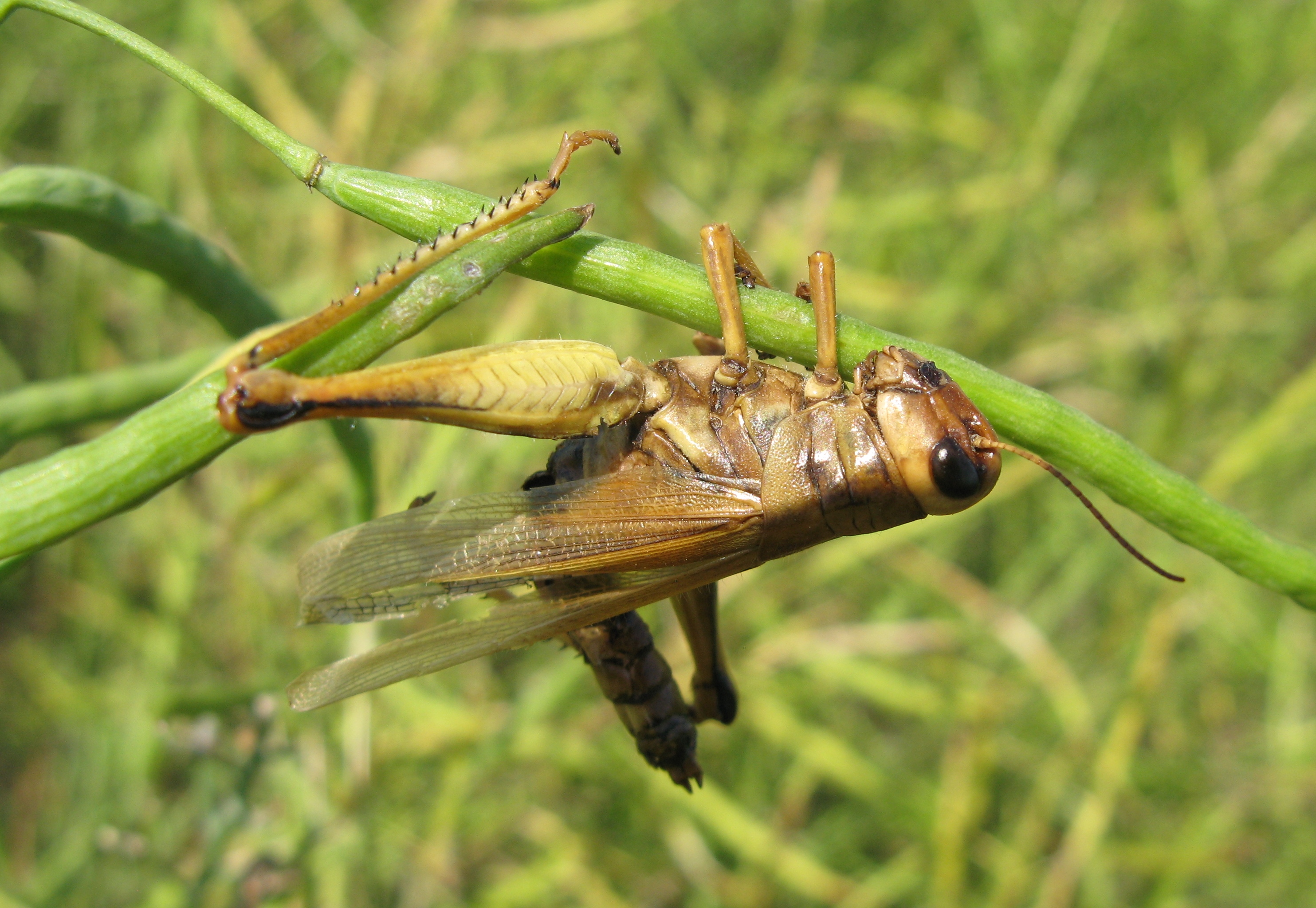
If insecticides are needed to control grasshoppers, remember to check the preharvest interval of the insecticides, which is the number od days that must pass between the insecticide application and swathing. For some products it will be too late in the season to use them on some crops.
Armyworms: Armyworms (Mythimna unipuncta) can be found in some of the cereal fields in the eastern and central part of Manitoba. Numbers are generally quite low, although there are some fields in the Beausejour and Lac du Bonnet area with some higher levels.
On a positive note, the 5 armyworms from a local field we had for our Crop Diagnostic School in Carman were all parasitized and eventually died. The picture below shows one of these larvae with an egg attached to its side. Depending on the type of parasitoid, the eggs may be laid on the side of the body like this, and highly visible, which is typical of many fly parasitoids, or the eggs may be laid right inside the body, as many wasp parasitoids will do.
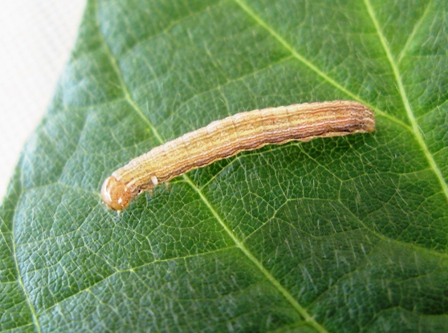
Cereal Rust
Leaf rust in winter wheat was observed in the MCVET trials in Carman and Winnipeg over the last week (see image below). This is the first report of cereal rust in Manitoba this year and it has not been reported in commercial fields. Pustules were observed mostly on lower leaves and at low severity. The MCVET trials do not receive any fungicide applications. Due to its late arrival this year, cereal rusts will not have an impact on yield as most crops in the province are further advanced. The latest a fungicide ever needs to be applied in wheat is at the FHB timing ie. full head emergence to early anthesis.
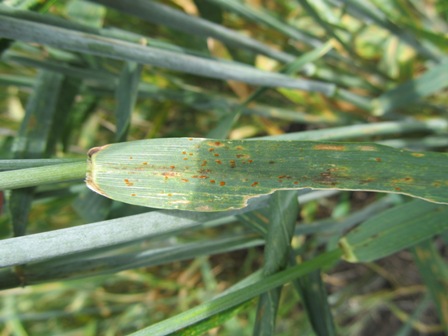
Fusarium Head Blight
Surveying of winter wheat for FHB began this week. To this point, fields in the Red River Valley have been surveyed and low levels of FHB have been reported. Symptoms of the disease are easy to find in the field, but overall at low incidence and severity. All fields that have been surveyed received a fungicide application at the FHB timing.
Insects in Corn: Egg masses of European corn borer can now be found under the leaves in some corn fields. So this is the proper time to be scouting corn for European corn borer. Once the eggs hatch, the first 2 instars of larvae feed on the leaves and the feeding looks like shotholes or widowpaning. It is the third instar larvae that bore into the stalk. The first 2 instars will complete development in 7 to 10 days. Below is a photo of an egg mass of European corn borer.
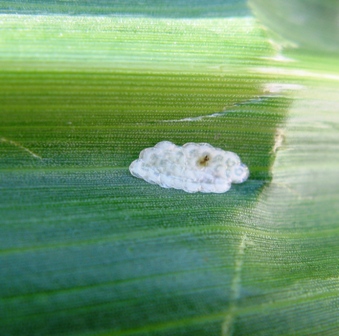
Insects in Soybeans: Low levels of soybean aphids have been found in the area north of Carman and near Starbuck. Currently the levels that have been found are quite low. In many years the populations can be contained at these low levels by natural enemies. So when scouting soybean fields, look on some of the trifoliates for soybean aphids, and also note if some of the key natural enemies such as lady beetles, minute pirate bugs, or hover fly larvae may be present.
Root Rots in Soybeans
From across the province, reports have been coming in of soybeans with a range of symptoms that may be attributable to root rots. Some of these symptoms include a girdling of the stem at the base and plants beginning to fall over or lodge (especially when accompanied by heavy rain or high winds), dead or wilted plants, yellowing plants with a shrivelled root system, etc. In some cases the plants that are falling over or breaking off at the stem base appeared healthy up to that point. Even with infected roots and hypocotyls there may still be vascular tissue in the plant that is able to transport water and nutrients assuming they are in adequate supply, however these plants are not as structurally strong so high winds or heavy rains can lead to stem breakage.
Surveys and Forecasts
Bertha Armyworm:
Trap counts over the past week have become very low. Populations of the moths have peaked and fewer moths would now be present. So for those with traps out, the traps can be removed after you collect this weeks data.
Highest cumulative counts are:
Risk of bertha armyworm based on moth capture in pheromone-baited traps
0-300 = Low risk 300-900= Uncertain risk 900-1,200= Moderate risk 1,200+= High risk | |
|---|---|
| Location | Total Count |
| Elm Creek | 1070 M |
| Zelena (north of Roblin) | 996 M |
| Sperling | 967 M |
| Manitou | 868 U |
| Makaroff (north of Roblin) | 791 U |
| Ridgeville (northeast of Emerson) | 770 U |
| Somerset | 740 U |
| Tummel (south of Roblin) | 723 U |
A table showing data from the bertha armyworm monitoring program can be viewed on the MAFRI website at:
When scouting canola fields, look for larvae of bertha armyworm. So far only low levels of larvae have been noticed. Many larvae will still be small and harder to notice. Also note that populations of bertha armyworm can vary greatly between fields within a region, so assumptions regarding a field can not be made based on findings in nearby fields.
Insect Identification Quiz
The species of insect in the photo below can sometimes be found on canola plants. They are generally not an economical threat to the crop, but are quite noticeable because of their metallic colours, and they are often near the top of the plants.
What is this insect?
Can you see any other insects (at any development stage) in this photo?
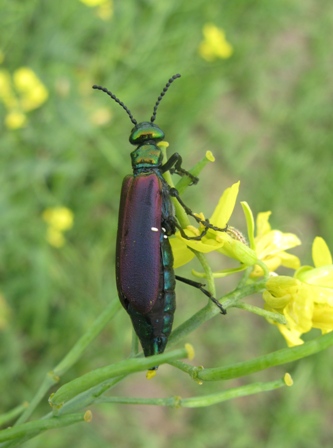
Answer: This is Nuttall blister beetle (Lytta nuttalli). It is one of a few types of blister beetles that can be found in field crops in Manitoba. If you look at the side of the beetle you will notice 3 eggs stuck to the side. These are eggs of a parasitoid. After the eggs hatch the larvae will live and feed inside this blister beetle, eventually killing the blister beetle.
Compiled by:
- John Gavloski, Entomologist
Manitoba Agriculture, Food and Rural Initiatives
Phone: (204) 745-5668
Fax: (204) 745-5690. - Holly Derksen, Plant Pathologist
Manitoba Agriculture, Food and Rural Initiatives
Phone: (204) 750-4248
Fax: (204) 745-5690
To report observations on insects or plant pathogens that may be of interest or importance to farmers and agronomists in Manitoba, please send messages to the above contact address.
To be placed on an E-mail list so you will be notified immediately when new Manitoba Insect and Disease Updates are posted, please contact John Gavloski at the address or numbers listed above.

